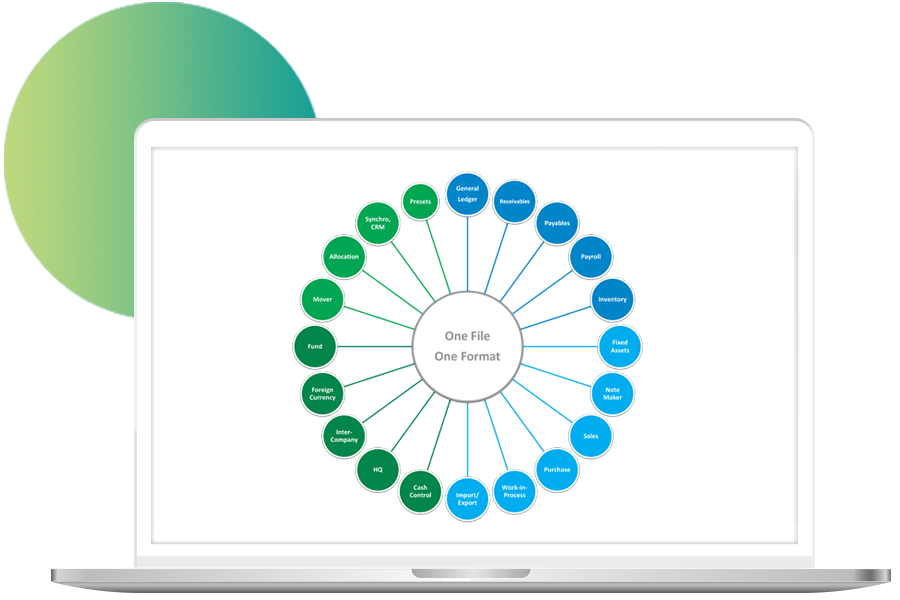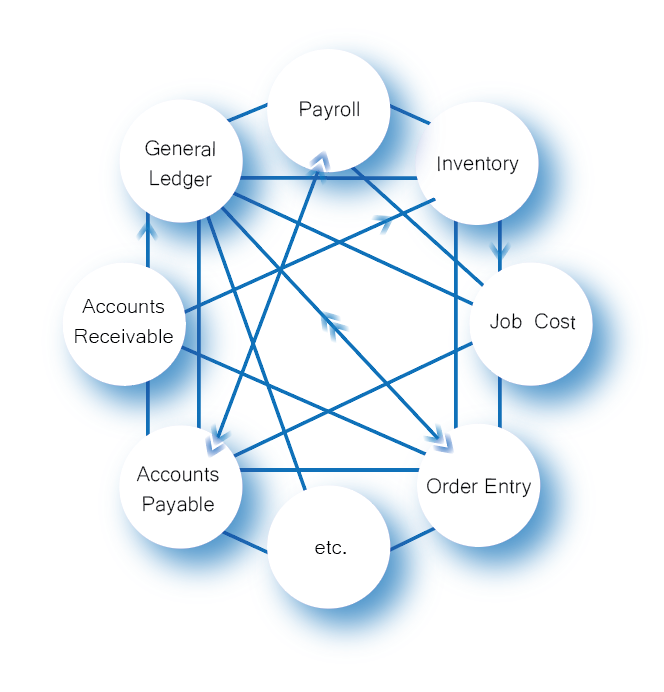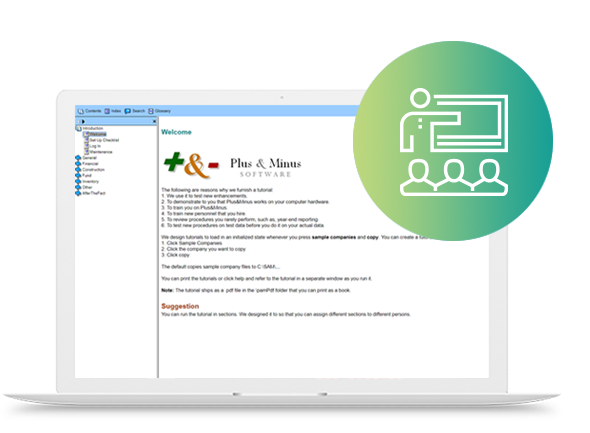
Design
Plus & Minus’ single file design uses one file to store transactions. The software industry refers to our design as a flat-file database. We took this a step further and designed structural relationships among the records, eliminating a search index.
The Plus & Minus developers use one format, consisting of: Gen, Sub, Invoice, Reference, Date, Journal, Amount, and Description. The original design has never changed. From the days of a simple bookkeeping system to a fully developed management information system, the developers have never found a need to change the structure or the format.
When you couple the single file with one format, only one key is needed to find any record in the file, thus making response queries instant. In addition, programmers can use just one comparison routine throughout Plus & Minus for searching.
Single-File vs Modular-based systems
Today’s business accounting software is multi-file based, meaning that the information for accounts payable is in an accounts payable file, the payroll information is in a payroll file, the receivables information is in a receivables file, and so forth. The problem with this approach is that, because each file has its own unique structure, records from one file cannot be easily joined with records from another. Multi-file design systems require users to perform a series of interfacing techniques to join the payroll, accounts payable, accounts receivable, and all other sections with the general ledger.
Modular-based systems are a spiderweb of complexity. Procedures such as “batching,” “posting,” and “closing” are mandatory components of a rigid cycle for purposes of producing reports, while module reconciliations are a continuous, tedious process. Over the years, modular systems have minimized “batching” and “posting” by creating temporary files that hold transactions until posting, adding yet another layer of complexity.
So many accounting systems are burdened with this cumbersome, archaic interfacing overhead. Meanwhile, the Plus & Minus single-file design is much simpler in concept, and it is far more efficient and easier to operate than modular or multi-file systems.


Discipline
Single-file design forces a design discipline over all functions. Users can quickly understand the information flow because of the single-file design structure. You locate transactions by positioning, rather than having to determine what module to use.

Time Independance
- The developers use a century-year-month-day format (ccyy/mm/dd)
- You enter data using mm/dd/yy or dd/mm/yy but internally it stores as ccyy/mm/dd
- There are no postings and no closings
- All transactions are available all the time

Structure
- The developers store transactions in 64-byte records, with 8 records per sector (sectors are 512 bytes.) This eliminates “sector overlap” and minimizes search disk access times
- Construction
- The designers store data stores as a binary string, making it hard to hack. They also store values in the Intel format, right-to-left, which is another technique used for speed, programming simplicity, and reliability
- Our customers report speeds of up to 22 million records per minute, while we clock performance running over the internet at 10 to 14 million records per minute

Reliability
Flat file is the most reliable storage technique in the industry. For instance, it is used in both Microsoft Excel and Word. There is no record locking in Plus & Minus, thus minimizing operating system overhead and the chance of data corruption.

Redundancy
There are several critical routines that write and read back to authenticate transactions on the server. With a LAN (Local Area Network), this technique provides rock-solid reliability. On the Internet, this technique handles communication drops without exception. For example, if you write multiple checks in one session, the DayTrans file is closed and re-opened after each check. This technique is utilized in all functions.

Reconciliation
There are no module reconciliations since all reports come from one file in Plus & Minus.
It is important for new users to get used to the software’s date sensitivity. For example, reports run with different dates. Even one day can produce different results.

Merge (Maintenance)
There are two files in Plus & Minus:
- DayTrans: It records new transactions introduced into Plus & Minus. Each user “owns” a portion of the file and is responsible for their portion, thus eliminating “record contention.” It also mirrors the history file
- History: Repository for merged records

Searching
The DayTrans uses a standard database search engine, while the history file uses a proprietary routine similar to the Google search engine.

Chart of Accounts (Gen)
The Gen chart of accounts is the backbone of Plus & Minus, and it is rarely changed. There is, however, a mover that allows you to globally search and replace gen accounts at any given time. So, it is not set in stone. All companies modify their general chart of accounts over time to reflect operational changes.
The gen chart is the “Uniform Chart of Accounts” you see in large companies. It provides structure for reporting functions. You can use anywhere from three to five digits, search by description, number, or string, and you can organize the gen chart into 16 logical groups, making it easier to search (e.g., cash, fixed assets, revenues, costs, selling, G&A, etc.)
The Sub chart of Accounts changes daily (e.g., new customers, vendors, employees, fixed assets, or modifications to existing customers vendors, employees, fixed assets, etc.)
- You can use up to 12 numeric digits
- One file handles up to 99 sub sets, defined as: customers, vendors, employees, banks, fixed assets, jobs, etc.
- Search by description, number, or string
The Links define sub sets.
You use the link to classify a set of subs as:
- Banks
- Customers
- Vendors
- Employees
- Fixed Assets
- Insurance contracts
- Accruals
- Departments
- Jobs
- Product lines

Only Once
You can introduce transactions into Plus & Minus by:
- Entry/Edit (manual)
- Function (sales, purchase, check writer, payroll, etc.)
- Translate Import
- Com object (custom or 3rd party systems)
Transactions are available throughout Plus & Minus.

Translation
You can import transactions from:
- Excel
- ASCII (via CSV format)
You can export most reports and all transactions to:
- Excel
- ASCII (via CSV format)
The “Report Writer Matrix” allows you to generate high level reports using Excel.
These reports are usually designed for external reporting:
- Up to 10,000 rows
- Up to 250 columns
- Graphs
- Fonts
- Colors
- Company consolidation
You do not have to learn a report generator language with this tool.

Reporting
There is no posting, closing, and no pre-defined periods in Plus & Minus.
You virtually define a period when you run a report:
- From one day to multiple years
- Date buttons to set dates for common periods:
- Day
- Week
- Month
- 1st, 2nd, 3rd, 4th quarter
- Year
- Etc.
You do not have to learn a report generator language with this tool.
In Plus & Minus, you open a new year versus closing a year in other systems.
When opening a new year, our software creates a journal zero in the current year, equal to the ending balance of the previous year. The opening shifts the report base forward by one year. This technique allows you to “see through” multiple years and report them, generating the same balance.

Presets
Presets are used to store range settings for all report functions and most translate functions. They eliminate the need to know your gen/sub culture and allow you to produce recurring reports quickly. You can also use them to utilize terminology familiar to your staff, design reports for operations (non-accounting) personnel, and create special one-time reports. Each user can create up to 99 presets for each function.

Past, Present, and Future
- Transactions can be present, past, or future
- You can introduce transactions from January 1, 1964, through December 31, 2063
- The “pivot date” is plus or minus fifty years from the system date
- It is possible to exceed these dates by using a ccyy/mm/dd format for importing
- You can limit date introductions with date controls, and the controller has two methods: boundary and blocker. Boundary (by user) includes lockout and warning, and blocker includes all users
- You can re-open a year after recording adjustments in previous periods
- You can record entries into the future (e.g., rent payments, tax accruals, note payments, etc.)

Memory Footprint
Plus & Minus uses a “run-time-system” that loads into memory when you start. The run-time-system carries all the routines’ needs and allows Plus & Minus to run at the same speed on desktops, laptops, local area networks, and the internet.

Are you ready to get started?
